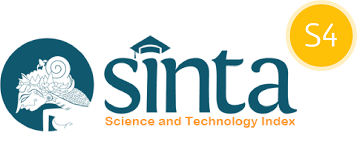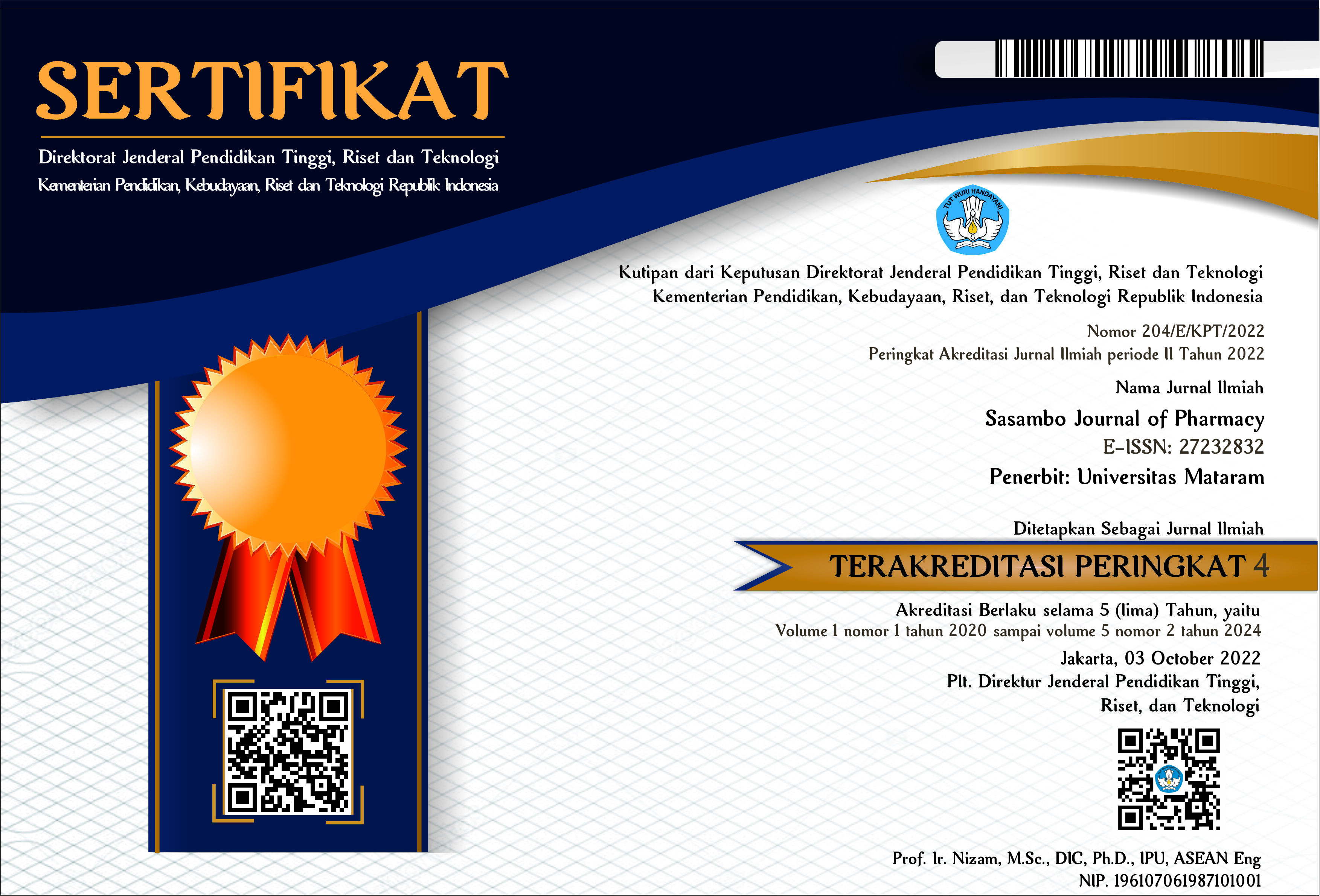Molecular docking of the bioactive compound Ocimum sanctum as an inhibitor of Sap 1 Candida albicans
DOI:
10.29303/sjp.v3i1.157Downloads
Abstract
Candida albicans (C. albicans) is the norm microbiota that lives in humans' oral cavity, digestive tract, and urinary tract. However, C. albicans, under certain circumstances can cause superficial infections of the mucosa such as oropharyngeal candidiasis (OPC) or vulvovaginal candidiasis (VVC) and even systemic infections. Secreted aspartic proteinase (Sap) 1 plays a role in the phenotype change of C. albicans. The study aimed to perform molecular docking using the bioactive compound Ocimum sanctum to inhibit Sap 1 C. albicans. Methods used include preparation of protein structures, ligands preparation, simulation of docking, and analysis and visualization. The results showed Apigenin had the highest binding energy of 7,792 kcal/mol and was followed by methyl eugenol ligand 5,361 kcal/mol, Citral 5,307 kcal/mol, Ursolic acid 4,967 kcal/mol, and Taxol 2,118 kcal/mol. Known interactions from the docking results showed that the four ligands hit the catalytic residue Asp32/Asp218, but only ursolic acid did not hit the catalytic residue. This study concludes that all ligands have binding energies that inhibit Sap 1, resulting in various interactions, amino acid residue contacts, and dissociation constants.
Keywords:
Candida albicans, Molecular docking, Sap 1, Ocimum sanctumReferences
Ali, N. S. M., Salleh, A. B., Leow, T. C., Rahman, R. N. Z. R. A., & Ali, M. S. M. (2020). The Influence of Calcium toward Order/Disorder Conformation of Repeat-in-Toxin (RTX) Structure of Family I.3 Lipase from Pseudomonas fluorescens AMS8. Toxins, 12(579), 1–14. https://doi.org/10.3390/toxins12090579
Borah, R., & Biswas, S. P. (2018). Tulsi ( Ocimum sanctum ), excellent source of phytochemicals. International Journal of Environment, Agriculture and Biotechnology, 3(5), 1732–1738.
Borelli, C., Ruge, E., Jung, H. L., Schaller, M., Vogelsang, A., Monod, M., … Maskos, K. (2008). X-ray structures of Sap1 and Sap5: Structural comparison of the secreted aspartic proteinases from Candida albicans. Proteins: Structure, Function and Genetics, 72(4), 1308–1319. https://doi.org/10.1002/prot.22021
Correia, A., Lermann, U., Teixeira, L., Cerca, F., Botelho, S., Gil Da Costa, R. M., … Pais, C. (2010). Limited role of secreted aspartyl proteinases Sap1 to Sap6 in Candida albicans virulence and host immune response in murine hematogenously disseminated candidiasis. Infection and Immunity, 78(11), 4839–4849. https://doi.org/10.1128/IAI.00248-10
Cortés-BenÃtez, F., Roy, J., Perreault, M., Maltais, R., & Poirier, D. (2021). 16-Picolyl-androsterone derivative exhibits potent 17β-HSD3 inhibitory activity, improved metabolic stability and cytotoxic effect on various cancer cells: Synthesis, homology modeling and docking studies. Journal of Steroid Biochemistry and Molecular Biology, 210(October 2020), 1–13. https://doi.org/10.1016/j.jsbmb.2021.105846
Dhorajiwala, TM., Halder, ST., Samant, L. (2019). Comparative in silico molecular docking analysis of L-Threonine-3-Dehydrogenase, a protein target against african trypanosomiasis using selected phytochemicals. J App Biotechnol, 6(3), 101-108. doi:10.29252/JABR.06.03.04
Gao, M., Nie, K., Qin, M., Xu, H., Wang, F., & Liu, L. (2021). Molecular mechanism study on stereoâ€selectivity of α or β hydroxysteroid dehydrogenases. Crystals, 11(3), 1–25. https://doi.org/10.3390/cryst11030224
Gonzalez, T. L., Rae, J. M., Colacino, J. A., & Richardson, R. J. (2019). Homology models of mouse and rat estrogen receptor-α ligand-binding domain created by in silico mutagenesis of a human template: Molecular docking with 17β-estradiol, diethylstilbestrol, and paraben analogs. Computational Toxicology, 10(October 2018), 1–16. https://doi.org/10.1016/j.comtox.2018.11.003
Hariono, M., & Rollando. (2016). Molecular docking of compounds from Chaetomium sp. against human estrogen receptor alpha in searching anti breast cancer. Jurnal Farmasi Sains dan Komunitas, 13(1), 35–43.
Hube, B., Sanglard, D., Odds, F. C., Hess, D., Monod, M., Schäfer, W., … Gow, N. A. R. (1997). Disruption of each of the secreted aspartyl proteinase genes SAP1, SAP2, and SAP3 of Candida albicans attenuates virulence. Infection and Immunity, 65(9), 3529–3538. https://doi.org/10.1128/iai.65.9.3529-3538.1997
Kharisma, V. D., Ansori, A. N. M., Widyananda, M. H., Utami, S. L., & Nugraha, A. P. (2020). Molecular simulation: The potency of conserved region on E6 HPV-16 as a binding target of black tea compounds against cervical cancer. Biochemical and Cellular Archives, 20(August), 2795–2802. https://doi.org/10.35124/bca.2020.20.S1.2795
Naglik, J., Albrecht, A., Bader, O., & Hube, B. (2004). Candida albicans proteinases and host/pathogen interactions. Cellular Microbiology, 6(10), 915-926. doi:10.1111/j.1462-5822.2004.00439.x
Pandey, A. K., Singh, P., & Tripathi, N. N. (2014). Chemistry and bioactivities of essential oils of some Ocimum species: An overview. Asian Pacific Journal of Tropical Biomedicine, 4(9), 682–694. https://doi.org/10.12980/APJTB.4.2014C77
Pandey, S. K., Yadav, S., Goel, Y., Temre, M. K., Singh, V. K., & Singh, S. M. (2019). Molecular docking of anti-inflammatory drug diclofenac with metabolic targets: Potential applications in cancer therapeutics. Journal of Theoretical Biology, 465, 117–125. https://doi.org/10.1016/j.jtbi.2019.01.020
Polke, M., Hube, B., & Jacobsen, I. D. (2015). Candida survival strategies. In Advances in Applied Microbiology (Vol. 91). https://doi.org/10.1016/bs.aambs.2014.12.002.
Raj, V., Lee, J.-H., Shim, J.-J., & Lee, J. (2022). Antiviral activities of 4H-chromen-4-one scaffold-containing flavonoids against SARS–CoV–2 using computational and in vitro approaches. In Journal of Molecular Liquids (Vol. 353). https://doi.org/10.1016/j.molliq.2022.118775
Shakya, A. K. (2016). Medicinal plants: Future source of new drugs. International Journal of Herbal Medicine, 4(4), 59–64. https://doi.org/10.13140/RG.2.1.1395.6085
Sjam, K. R. (2012). Kolonisasi Candida dalam Rongga Mulut. Majalah Kedokteran FK UKI, 28(1), 39–47.
Srivastava, S., Shree, P., Pandey, H., & Tripathi, Y. B. (2018). Incretin hormones receptor signaling plays the key role in antidiabetic potential of PTY-2 against STZ-induced pancreatitis. Biomedicine and Pharmacotherapy, 97(July 2017), 330–338. https://doi.org/10.1016/j.biopha.2017.10.071
Tumilaar, S. G., Siampa, J. P., & Tallei, T. E. (2021). Penambatan Molekuler Senyawa Bioaktif dari Ekstrak Etanol Daun Pangi (Pangium edule) Terhadap Reseptor Protease HIV-1. Jurnal Ilmiah Sains, 21(1), 6–16. https://doi.org/10.35799/jis.21.1.2021.30282
Valmas, A., Dedes, G., & Dimarogona, M. (2020). Structural Studies of a Fungal Polyphenol Oxidase with Application to Bioremediation of Contaminated Water. Proceedings, 66(1), 10. https://doi.org/10.3390/proceedings2020066010
Venkatachalam, K. V., & Ettrich, R. H. (2021). Role of aspartic acid residues D87 and D89 in APS kinase domain of human 3′-phosphoadenosine 5′-phosphosulfate synthase 1 and 2b: A commonality with phosphatases/kinases. Biochemistry and Biophysics Reports, 28, 101155. https://doi.org/10.1016/j.bbrep.2021.101155
Wächtler, B., Citiulo, F., Jablonowski, N., Förster, S., Dalle, F., Schaller, M., … Hube, B. (2012). Candida albicans-epithelial interactions: Dissecting the roles of active penetration, induced endocytosis and host factors on the infection process. PLoS ONE, 7(5). https://doi.org/10.1371/journal.pone.0036952
License
Copyright (c) 2022 The Author(s)

This work is licensed under a Creative Commons Attribution 4.0 International License.
Authors who publish with Sasambo Journal of Pharmacy (SJP), agree to the following terms:
- Authors retain copyright and grant the journal right of first publication with the work simultaneously licensed under a Lisensi Creative Commons Atribusi 4.0 Internasional. This license allows authors to use all articles, data sets, graphics and appendices in data mining applications, search engines, web sites, blogs, and other platforms by providing an appropriate reference. The journal allows the author(s) to hold the copyright without restrictions and will retain publishing rights without restrictions.
- Authors are able to enter into separate, additional contractual arrangements for the non-exclusive distribution of the journal's published version of the work (e.g., post it to an institutional repository or publish it in a book), with an acknowledgment of its initial publication in Sasambo Journal of Pharmacy
- Authors are permitted and encouraged to post their work online (e.g., in institutional repositories or on their website) prior to and during the submission process, as it can lead to productive exchanges, as well as earlier and greater citation of published work (See The Effect of Open Access).







